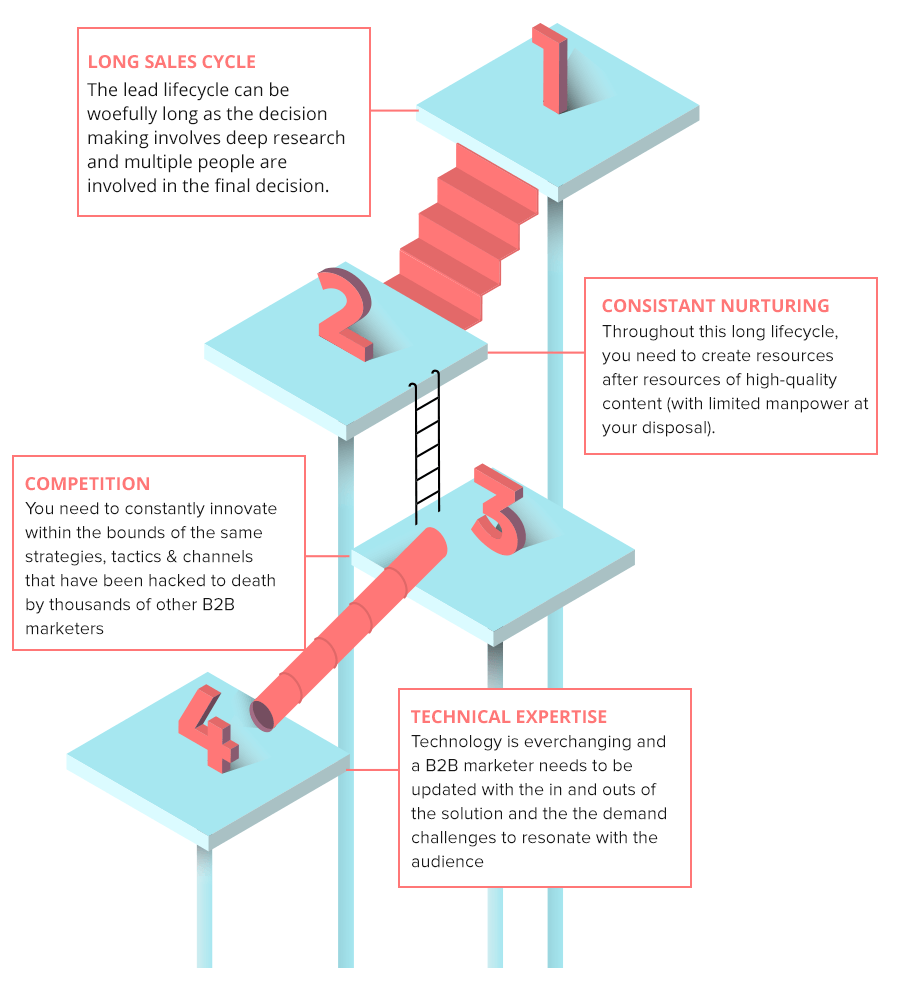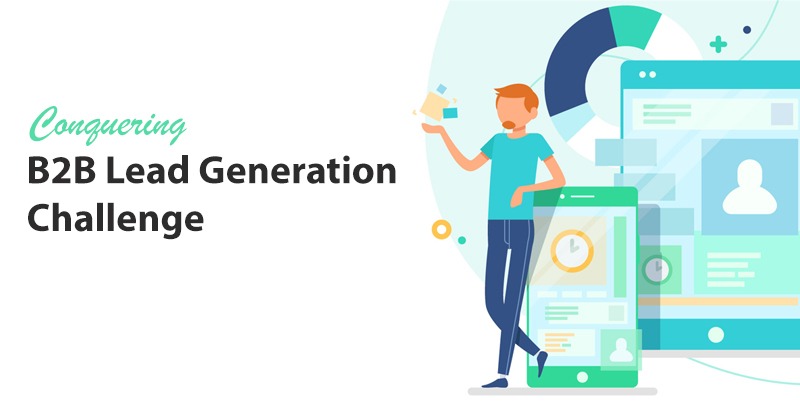B2B lead generation is challenging – if you are in the industry, you’re probably nodding along. If you ask any B2B marketer to make a wish, it would most likely be – more leads, better leads. This BrightTALK study confirms the same – 68% marketers say their top priority is increasing lead quality, whereas 55% say theirs is increasing lead volume.
The equation is really simple – More leads, better leads.
Simple, but not easy. B2B lead generation is tough because you are vying for attention in a space already overcrowded by businesses just like you, trying to sell the same services as you, at the same cost as you. Below is an infographic summing up the top four challenges faced by B2B marketers for lead generation.
B2B lead generation challenges and how to overcome them?

Lead generation is a high-pressure job, and sometimes when the stakes are high, we usually forget the basics and fall into the trap of trying too many things as we hear them. We hear multiple ideas parroted to us – create infographics, create videos, tweet 12 times a day among others – and lose sight of our broader goal. It is true that all these things help, but they help only when you have the basics covered. It all starts with understanding the customer.
I know, it’s a cliché – but it’s such a widely repeated cliché for a reason – it’s true. Anyway, we will come back to it later. Let’s go into the challenges in more detail.
Long sales cycle

Well, you can’t really do much about this one because that is the nature of the business: You are trying to convince a whole bunch of people with different pain points and expectations, to buy from you. But it doesn’t mean you can do nothing about it.
Target right to start with
The best thing you can do to cut the long sales cycle short is choosing the best leads.
You spend months following up and sending great content, only to hear that they don’t want to go ahead anymore. It is OK to lose to a competitor but it is really frustrating if you targeted the wrong guy in the wrong company to start with. All that time you spent on nurturing them would have been better utilized at a better place. Choosing the right battle sums up this point nicely.
Reach the decision makers early
Most of the time, influencers will shortlist products or services as asked by their managers. Convincing them is a good way to climb the ladder. Help them understand why you are different and better than others. Also, help them with resources like case studies, testimonials, etc., down the road, which they can then present to the management to get them to listen to you. Another thing is that you can learn a lot about the process and the requirement, and thereafter, pitch your solution to the top management accordingly.
Lack of resources

In other words – cadence.
Getting their mindshare is not going to work without cadence. A lot of people confuse cadence with frequency. It is not the number of emails you send in a given time. It is the right amount of emails at the right interval to the right audience.
Easier said than done though. It is not easy to write original, compelling content week after week. It demands a lot of skill, hard work, and patience. There are ways in which you can solve this challenge.
Repurpose
You do a kick-ass webinar and send the recording to all the attendees. Now, why not create an infographic or a cool whitepaper? Why not post the answers on Quora? Why not spread the word on LinkedIn forums. Sure, it requires distribution tricks but definitely takes a shorter amount of time compared to starting something from scratch.
Let the experts work for you, for free. Invite the masters and give them due credit for writing your articles, taking your webinars and doing your podcasts. Nobody hates free promotion but you need convincing skills to do that. Plus, tell them what they will get out of it.
Outsource
Find platforms like Fiverr, 99designs, Upwork, etc., to get your design and content writing done.
Competition

Losing to the competition is more painful in B2B because of the time and effort you invested in the prospect. But there are things you can do to beat the competition.
Know your competitor
To compare a and b you need to know a and b. You can’t really know your product and compare it without knowing the other one’s product. So keep a close watch on your competition and create your USP from there – that, is the correct message.
Use Marketing Automation
Marketing automation is not just a series of automated emails. It is much more than that. Lead segmentation, sending relevant content at the right time, combining sales and marketing teams, analyzing data and refining your content are just some of the components of a marketing automation platform.
Technical expertise

Technology is ever-changing and essentially a marketer is making technology meet their customers. Well, I am not asking you to learn HTML or SQL but you should know enough to take a solution-focused approach like – how will the systems integrate, role of APIs and so on. These are important discussions in the sales process.
Listen to demo/meeting/call recordings
Always make sure that you are up-to-date with the recordings of the client’s conversations. They give valuable insights to real world problems and give you the perspective of the technical difficulties your customers are facing.
Spend some time with the tech team
The tech team should get more involved with sales and marketing. It is a two-way benefit. They will learn how the world is using their product or service and the marketing team will understand the developer’s perspective of building something, which eventually will help them in speaking the language other techies understand.
On closing note
All these B2B lead generation challenges have a core component called customer understanding. If you know your customer well – you will find a way to nurture them with valuable content and make the sales cycle shorter. You will position your product or service properly and beat the competition.
The key to conquering B2B lead generation is understanding the customer.









